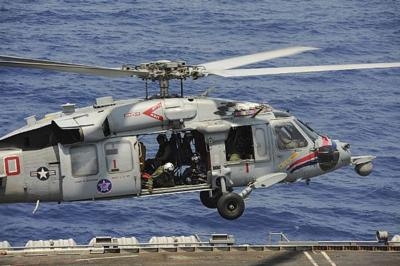MH-60S Nighthawk Helicopters Plucking People, Pets From Precarious Situations
Two Navy helicopter squadron detachments have relocated to Easterwood Airport after making 227 helicopter rescues while flying from Fort Worth on their first day in the region.

The 112 Sailors from the Dusty Dogs and Ghostriders of Helicopter Sea Combat Squadrons (HSC) 7 and 28 (respectively) moved their staging site and six MH-60S Knighthawk helicopters in order to be even closer to the disaster zone in the wake of Hurricane Harvey. The new site will allow for a drastically reduced response time.
Regardless of response time though, the large cabin space, infrared capabilities, search and rescue trained crews and robust, dynamic lighting capabilities make the Knighthawk and her crew an ideal choice for the mission. "We have multiple systems within the helicopter that allow us to fly at night, with the forward looking infrared camera, or FLIR ball, as we call it, up forward that allows us to look around at night." said helicopter pilot Lt. Grant Kingsbery, a Uvaldi, Texas native and Texas A&M graduate. "We have spotlight and floodlight that allows us to look around and everyone in the crew is wearing night-vision goggles to help us see better."
In addition to the visibility aides, the helicopters are equipped with an onboard rescue hoist, the ability to hover at night and an average of 3 hours of fuel to aide in the efforts.
In a typical Navy scenario, HSC squadrons serve aboard ships, often hovering over the ocean and serving as plane guards for other aircraft that may launch off ships. The city scape, however, proved to be a drastic change for the crew from their typical flights. "In the open ocean you don't have to worry about towers - you're 70 feet over the water, you don't have to worry about running into anything," Kingsbery said. "Here, especially with the power outage, the street lights are out and most of the towers are unlit now because their battery backup has run out."
Lt. Benjamin Bontrager, a pilot from yesterday's rescue mission and native of Mishawaka, Indiana, said, "my goal the entire night was to fly as fast as I can, as safely as I can and as precisely as I can to make sure that those people get out of the terrible situation they were in."
About the conditions as they compare to typical Navy flights, Bontrager said it's a much more crew intensive environment. "It poses a greater safety risk with the towers and other aircraft flying around. We've got, you know, 40 aircraft flying around at one time in a small area all trying to do the same thing," he said. "It's a very task-saturated environment, and when you add nighttime to it, it's just that - times ten."
Naval Aircrewman (Helicopter) 2nd Class Danny Harlow, a rescue swimmer who assisted in the rescues yesterday and native of San Diego, CA told the story of a memorable rescue. "We were flying around looking for opportunities and I saw a family waving white towels from their balcony so I immediately called my pilot 'right' and we came over the spot," Harlow said. "There were two kids down there with asthma, their mother, and their uncle - who just underwent a kidney transplant - and luckily I was able to get the opportunity to get in there and get them up into the helicopter and into safety."
Harlow spoke vividly of the emotions involved. "We actually had a wide range of emotions, some were extremely grateful, some were terrified, some were crying. Some of the kids were actually having fun because they were in a helicopter," he said. "So it really was a wide range, but definitely gratifying. Getting them out and having those 'Thank Yous' is definitely a gratifying experience."
Naval Aircrewman (Helicopter) 2nd Class Jose Rodriguez, a native of Corpus Christi, Texas, is flying his first rescue mission tonight and is anxious to help his fellow Texans. He spoke to the mission of the aircrew and the training of the rescue swimmers. "We'll send the (rescue) swimmer down and he'll pick up whoever he needs to," he said. "When we send him down, he tries to calm the person down - whether he's in the water or on top of a house, wherever he's at, that's the first thing he does - and then he tells them who he is, how he's going to help them out, and how we're going to bring him back into the aircraft."
With regards to his own family, Rodriguez assures that they are safe. "My family ended up staying in Corpus Christi - they live on the outskirts - everything is okay with their home," he said. "They ended up losing power but I believe it is back on now."
HSC-7 has 77 Sailors and four helicopters while HSC-28 has 35 Sailors and two helicopters assigned to the relief efforts. At the start of the day, they had flown 13 sorties with 37 hours in the air, 227 rescues (21 by hoist), including 11 dogs and one kitten.
(Source: U.S. Navy news release. Image from file)
 ANN's Daily Aero-Term (04.26.24): DETRESFA (Distress Phrase)
ANN's Daily Aero-Term (04.26.24): DETRESFA (Distress Phrase) Aero-News: Quote of the Day (04.26.24)
Aero-News: Quote of the Day (04.26.24) ANN's Daily Aero-Term (04.27.24): Direct
ANN's Daily Aero-Term (04.27.24): Direct ANN's Daily Aero-Linx (04.27.24)
ANN's Daily Aero-Linx (04.27.24) Aero-News: Quote of the Day (04.27.24)
Aero-News: Quote of the Day (04.27.24)



